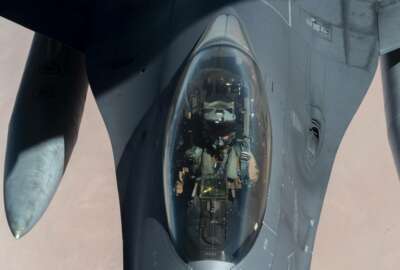

Airmen and Guardians are not permitted from being members of groups, but certain actions can jeopardize their careers.
The Air Force is showing its airmen what extremist behavior looks like, how to identify extremist groups and what activities are impermissible in the military as part of training required by the Defense Department to clamp down on violent and supremacist behavior in the service.
The slideshow, made by the Air Force Judge Advocate General’s Corps, warns airmen and guardians that they are “accountable for the culture, good order and discipline and safety of units. Impermissible behavior left unaddressed erodes unit trust and cohesion and places military lethality and effectiveness at risk.”
The training material also reminds service members that they have a responsibility to report a violation of law, policy, instructions or regulations.
The PowerPoint was first posted by the Facebook group Air Force amn/nco/snco, and its veracity was confirmed to Federal News Network by the Air Force. It explains to commanders how to discuss issues with their subordinates by fostering connection, it encourages seeking help and generating feedback on how to better help airmen.
On Feb. 5, Defense Secretary Lloyd Austin required all commanding officers and supervisors to conduct a one-day stand down to address extremism by April 6.
“We will not tolerate actions that go against the fundamental principles of the oath we share, including actions associated with extremist or dissident ideologies. Service members, DoD civilian employees, and all those who support our mission, deserve an environment free of discrimination, hate, and harassment,” Austin wrote.
A recent Pentagon report found that servicemembers are highly prized targets for right-wing extremist groups.
The Air Force training defines impermissible behavior as any conduct, action or statement that advances, encourages or advocates supremacist, extremist or criminal organization doctrine, ideology or cause. It is also the illegal use of force, violence or criminal activity and illegal discrimination based on race, creed, color, sex, religion, ethnicity or national origin.
“Stated differently, impermissible behavior is anything that negatively impacts good order and discipline,” one slide states.
The training goes on to define extremism as a “specific sub-category of impermissible behavior and is defined as a doctrine, ideology or cause characterized by, but is not limited to, a common belief which might otherwise be politically or socially acceptable, but espouses the use or threat of violence to obtain goals.”
The slides remind commanders that purely being a member of an organization is not prohibited. However, certain actions and advocacy violate code.
The slides tell commanders to remind airmen that no one is immune from being lured into the world of extremism, that there is a predictable pathway from a simple belief to an extremist ideology and that targeted violence is premeditated.
The materials give a handful of case studies like a civilian employee making statements declaring he was a member of the Proud Boys and threatening to overthrow the government and partake in a civil war following the Jan. 6 attacks on the Capitol.
The example states that Air Force Materiel Command issued an abatement order against the employee.
The slides break down extremist behavior into different levels, starting at interest in a group, then moving to using language, association, action and advocacy.
They also give commanders a list of personnel, administrative, disciplinary, investigative and judicial tools.
To date, the Pentagon has not released any information on how many servicemembers are part of extremist groups or engage in extremist behavior.
Copyright © 2025 Federal News Network. All rights reserved. This website is not intended for users located within the European Economic Area.
Scott Maucione is a defense reporter for Federal News Network and reports on human capital, workforce and the Defense Department at-large.
Follow @smaucioneWFED



